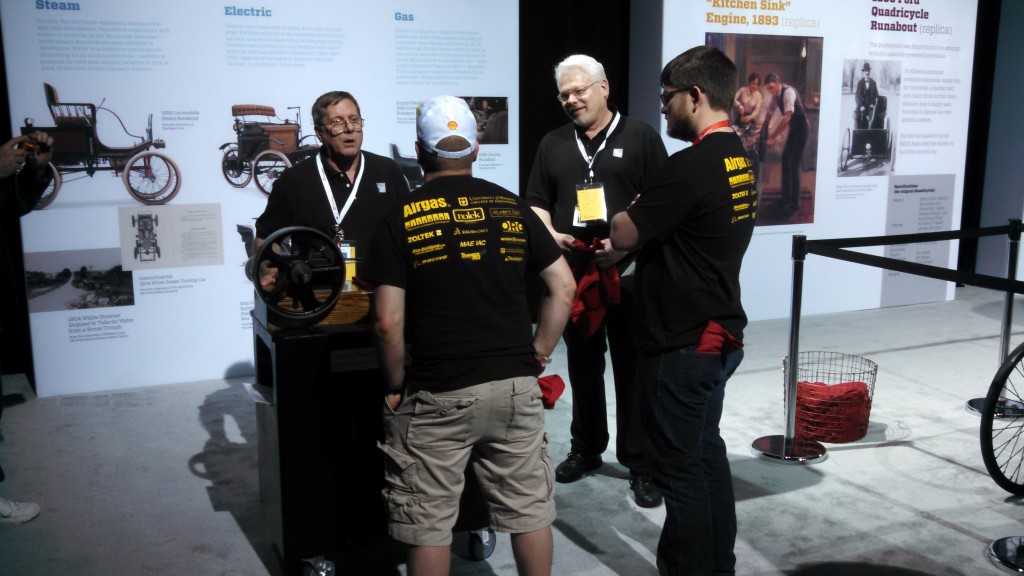Ultra-Mileage in the Motor City: The 2015 Shell Eco-marathon Americas

Earlier this month, we at The Henry Ford were excited to participate in the Shell Eco-marathon Americas, held in Detroit’s Cobo Center from April 9-12. More than 1,000 high school and college students, representing the United States, Canada, Brazil and Guatemala, competed to determine which of their 113 teams produced the car capable of the best fuel mileage.
Shell, the global energy company, sponsored fuel-mileage competitions as early as 1939, but more recently the Eco-marathon has evolved into three events held annually in Europe, Asia and the Americas. This year marks the first time that the Americas competition took place in the Motor City. Teams may enter cars in one of two classes. Prototype cars strive for maximum fuel efficiency with exotic materials and designs. Urban Concept cars resemble street vehicles complete with lights, signals and working horns. Teams using internal combustion engines may power their vehicles with gasoline, diesel, natural gas or ethanol. Those using electricity can choose between lithium-based batteries or hydrogen fuel cells. Whatever the fuel, the goal is the same: squeeze as much distance out of it as possible.

Walking around Cobo Center, I saw a remarkable variety of designs – some of which would stand up against anything a major manufacturer might build. While the Prototypes were all sleek and slender, I think I preferred the Urban Concepts. Students let their imaginations run wild, often using production vehicles as models. (I saw a couple of Volkswagen van homages – one complete with Scooby Doo in the rear window.) But the inspection process was serious business. Officials reviewed every car to confirm that fire extinguishers were aboard, that drivers could escape unassisted in ten seconds or less, that engine noise levels were within tolerable limits, and any number of other requirements. More than a few teams failed to make it past this step.
Those that qualified for the track faced a new set of challenges. The 0.9 mile course included a long climb up Woodward Avenue and a section of brick surface around Campus Martius. Each car had to complete seven laps – 6.3 miles – within 25 minutes, meaning that each car had to average around 15 miles per hour. That may not sound fast, but when you’re strapped into a lightweight, hand-built chassis with your backside just inches from the ground, it’s surely fast enough.
Canadian teams dominated the overall competition with numbers more than twice as good as their competitors. The University of Toronto squad achieved 3,421 miles per gallon with its gasoline-powered Prototype. The team from Laval University, in Quebec City, wasn’t far behind with 3,365 miles per gallon. (You can view the full results for all classes here.) The all-time record, though, still belongs to France’s Lycée Saint-Joseph La Joliverie. Its team achieved an astounding 7,797 miles per gallon in a gasoline Prototype at the 2014 Shell Eco-marathon Europe.

Ah, but what of The Henry Ford’s role? We were proud to partner with Shell in a series of exhibits open to the public, free of charge, for the duration of the event. We examined steam, electric and gasoline power in early automobiles in a display that included a working replica of Henry Ford’s 1893 “Kitchen Sink” Engine, a replica of Ford’s 1896 Quadricycle, and our 1922 Detroit Electric coupe. In another exhibit, we looked at the traits, inspirations and processes that led Henry Ford to build the Model T (complete with our “Build a Model T” activity, relocated for the weekend from Henry Ford Museum) and compared them with the same qualities found in the Eco-marathon teams. We displayed a high-mileage concept car from our collection, the X Prize-winning 2010 Edison2. We also created a sort-of lounge area where students and visitors could watch selected clips from The Henry Ford’s Innovation Nation. Finally, we passed out those tape-on-the-bridge “geek glasses” we use to promote Maker Faire because, in a genuine sense, the Eco-marathon students are makers.

If you missed this year’s competition, you haven’t missed out completely. The Shell Eco-marathon Americas will return to Detroit for 2016 and 2017. It’s well worth a visit to talk with the students, to watch the cars in action on the course, and to explore the countless exhibits and activities. It may even give you a peek into a more fuel-efficient future.
Matt Anderson is Curator of Transportation at The Henry Ford.
21st century, 2010s, Michigan, making, events, environmentalism, education, Detroit, childhood, cars, by Matt Anderson


Facebook Comments